标签:
1. 栈式布局管理器(QStackedLayout)
(1)所有组件在垂直于屏幕的方向上被管理
(2)每次只有一个组件会显示在屏幕上(类似于窗口的Z-Order,但只能显示最顶层的)
(3)只有最顶层的组件会被最终显示
2. 栈式布局管理器的特点
(1)组件大小一致且充满父组件的显示区
(2)不能直接嵌套其它布局管理器,但可以将一些组件放入一个layout,再将这个layout作为一个Widget的布局管理器。最后通过QStackedLayout.addWidget以达到嵌套的目的。
(3)能够自由切换需要显示的组件
(4)每次能且仅能显示一个组件
3. QStackedLayout的用法概要
(1)int addWidget(QWidget* widget);
(2)QWidget* currentWidget();
(3)void setCurrentIndex(int index);
(4)int currentIndex();
4. 计时器的概念及用法:
(1)计时器的概念
①计时器是工程开发中非常重要的角色
②计时器用于每隔一定的时间触发一个消息
③计时器消息最终会被转化为函数调用
④宏观上,计时器在每个时间间隔会调用指定的函数
(2)使用方法
①编写计时器消息处理函数
②在程序中创建计时器对象
③连接计时器消息和消息处理函数
④设置计时器时间间隔并启动计时
【编程实验】栈式布局和计时器的使用


//main.cpp

#include <QApplication> #include "Widget.h" int main(int argc, char *argv[]) { QApplication a(argc, argv); Widget w; w.show(); return a.exec(); }
//Widget.h
#ifndef _WIDGET_H_ #define _WIDGET_H_ #include <QWidget> #include <QPushButton> class Widget : public QWidget { Q_OBJECT private: QPushButton TestBtn1; QPushButton TestBtn2; QPushButton TestBtn3; QPushButton TestBtn4; void initControl(); private slots: void timerTimeout(); public: Widget(QWidget* parent = 0); ~Widget(); }; #endif //_WIDGET_H_
//Widget.cpp
#include "Widget.h" #include <QStackedLayout> #include <QHBoxLayout> #include <QTimer> #include <QDebug> Widget::Widget(QWidget* parent):QWidget(parent), TestBtn1(this),TestBtn2(this),TestBtn3(this),TestBtn4(this) { initControl(); } void Widget::initControl() { QStackedLayout* sLayout = new QStackedLayout(); QHBoxLayout* hLayout = new QHBoxLayout(); QWidget* widget = new QWidget(); QTimer* timer = new QTimer(this); TestBtn1.setText("1st Button"); TestBtn2.setText("2nd Button"); TestBtn3.setText("3rd Button"); TestBtn4.setText("4rd Button: Hello World!"); //为了达到QStackedLayout可嵌套,先新成一个新的Widget //里面包含2个Button,并做水平布局排放 TestBtn2.setParent(widget); TestBtn3.setParent(widget); hLayout->addWidget(&TestBtn2); hLayout->addWidget(&TestBtn3); widget->setLayout(hLayout); //生成栈式布局的各个组件 sLayout->addWidget(&TestBtn1); //0 sLayout->addWidget(widget); //1,嵌套的widget sLayout->addWidget(&TestBtn4); //2 sLayout->setCurrentIndex(0); setLayout(sLayout); connect(timer, SIGNAL(timeout()), this, SLOT(timerTimeout())); timer->start(2000); } void Widget::timerTimeout() { //取出Widget当前的布局管理器 QStackedLayout* sLayout = dynamic_cast<QStackedLayout*>(layout()); if(sLayout != NULL) { int index = (sLayout->currentIndex() + 1) % sLayout->count(); sLayout->setCurrentIndex(index); } } Widget::~Widget() { }
5. 小结
(1)QStackedLayout以栈的方式管理界面组件
(2)QStackedLayout中的组件最多只有一个显示
(3)QStackedLayout可以自由切换需要显示的组件
(4)QTimer是Qt中的计时器组件
(5)QTimer能够在指定的时间间隔触发消息
标签:
原文地址:http://www.cnblogs.com/5iedu/p/5451910.html